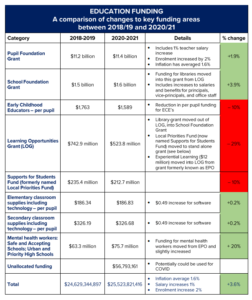Limited funding to support COVID adjustments in schools
On June 19th, the Ministry of Education released funding details for the 2020/2021 school year. While there was a small increase in funding for mental health supports, and a small increase for technology, no specific fu
nding has been announced to cover the increased costs that boards will incur to support school re-openings during COVID.
No funding announced to cover costs to support safe school re-openings
People for Education compared education funding for the 2020/21 school year to funding in 2018/19. This comparison paints a clearer picture because last year’s education funding was an anomaly.
While the 2020/21 funding includes approximately $56.8 million in “unallocated funds”, there does not appear to be any contingency funding for increased costs in a number of areas, including:
- Additional staff to comply with new health and safety standards for cleaning schools;
- More busing to support physical distancing requirements on buses and potentially staggered start times;
- Additional support staff for students struggling with learning loss;
- Increased numbers of teachers to support 15 student “bubbles” in elementary school and “quadmestering” in high school; or
- Personal protective equipment (PPE).
Boards receive half funding for students returning for extra year of high school
The funding details also flag that school boards may only receive half the per pupil amount for students who completed secondary school online this spring during the pandemic and who wish to come back for another year either to improve their marks or obtain more than the 34 required credits.
Funding for students at risk based on out-of-date statistics
Some of the funding for special education and in the Learning Opportunities Grant (to help students who are at greater risk of poor academic achievement) is allocated to school boards based on demographic data provided by Statistics Canada. This data includes things like the percentage of students in a board living in low-income households, the percentage who are recent immigrants, and the percent whose parents have less than a high school diploma. This funding is vital for boards as it can help to cover the costs of things like smaller class sizes, increased numbers of staff like guidance counsellors or child and youth workers, as well as things like breakfast and lunch programs.
Despite the fact that excellent census data is available from 2016, the Ministry of Education is still basing this funding on data from the 2006 census. The use of 14 year-old data may have a significant impact on the amounts boards receive.
Boards across Ontario requesting clarity and increased funding to support school re-openings
School boards must provide their plans to the province by August 4th. A number of boards have already outlined their increased needs if students are back in school, and if boards are following the guidelines laid out in the SickKids Recommendations for School Reopening and in the Ministry’s Health and Safety Guidelines. For example:
- The Toronto District School Board outlined a return to school plan that would cost more than $100 million to implement.
- The Ottawa Catholic District School Board chair says the board will ask for increased funding to “to cover COVID-19 costs such as personal protective equipment, extra staffing, transportation, technology, mental-health supports, cleaning supplies and school retrofits and maintenance.”
- The Waterloo District School Board estimates it will need at least $7.6 million more just for the first few months of school to cover costs for personal protective equipment, custodial supplies, and signage and barriers over the entire year.
Changing COVID situation makes comprehensive planning vital
School boards, parents, educators, support staff and others will have to be ready for a range of scenarios in the fall. It is possible that schools will open in September with regular class sizes and timetabling, or, at the other extreme, schools could be closed because of a sudden surge in cases COVID-19.
Being ready will require sets of contingency plans, as well as adequate resources. If learning is partly online, parents will need reliable child care for their younger children. Older students will need places like community centres or libraries staffed with adults other than their parents to support them. Whatever the situation, there will be no “back to normal.” Students – and staff – will need extra support. Some students will be struggling with learning loss, some with mental health issues. Students and staff may be dealing with ongoing anxiety in the face of the pandemic. And some will not feel able to return to school at all.
Right now, everyone is looking for certainty in uncertain times. A plan to provide even a little of that certainty will take collaboration and funding from all levels of government. It will take a willingness to cooperate, a recognition of the gravity of the situation, and lots of creativity.
